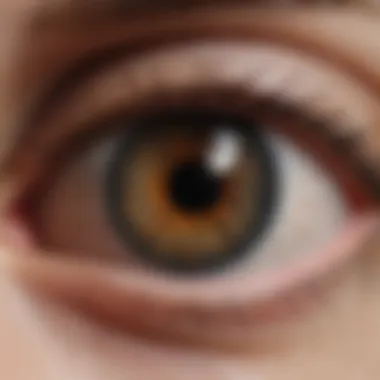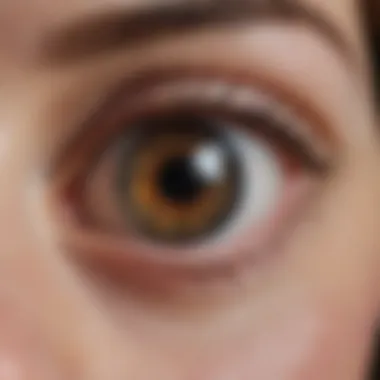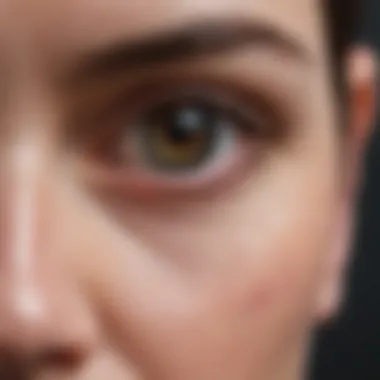Understanding Elevated Eye Pressure: 28 mmHg Insights


Intro
Elevated eye pressure, particularly when measured at 28 mmHg, is a condition that requires careful consideration due to its potential impact on vision and overall eye health. Understanding this phenomenon involves delving into multiple dimensions, including the anatomy and physiology of the eye, the role intraocular pressure plays in visual integrity, and the various methodologies employed to measure this pressure.
This article will guide readers through the nuances of elevated intraocular pressure, exploring its various causes and the visual disorders that may arise as a consequence. Furthermore, it will highlight diagnostic techniques, treatment options, and lifestyle modifications that can contribute to managing and preventing this condition. This comprehensive approach aims to enhance awareness and underscore the significance of regular eye examinations.
Research Overview
Methodological Approaches
A variety of approaches are utilized to study elevated eye pressure. Clinical studies often employ tonometry for accurate measurement of intraocular pressure. Among the common tonometric methods are Goldman applanation, non-contact tonometry, and palpation, each linking specific devices and techniques to pressures recorded.
In recent years, research has also explored the relationships between intraocular pressure and systemic factors such as blood pressure and metabolic health. Cross-sectional studies further investigate the prevalence of elevated eye pressure in different populations, providing essential data to understand demographic tendencies and risks.
Significance and Implications
The implications of maintaining healthy intraocular pressure are profound. Elevated pressure can lead to glaucoma, a condition that can result in irreversible vision loss if not managed properly. Regular monitoring is essential not only for those exhibiting symptoms but also for individuals with risk factors such as family history or systemically-induced conditions.
In regard to public health implications, raising awareness about the importance of routine eye check-ups can significantly reduce the incidence of late-stage glaucoma. Education surrounding this issue is paramount, particularly for those over 40, as the likelihood of developing elevated pressure increases with age.
Current Trends in Science
Innovative Techniques and Tools
Technological advancements are transforming the assessment of eye pressure. New devices, such as optical coherence tomography and laser scanning, are providing more precise measurements of eye structures, shedding light on not only intraocular pressure but also its impact on the optic nerve. These developments facilitate early detection and intervention, which can be crucial in preserving vision.
Interdisciplinary Connections
Understanding elevated eye pressure transcends traditional ophthalmology. Insights from fields such as neurology and endocrinology can enrich research. For instance, studies linking diabetes and elevated intraocular pressure exemplify how systemic health impacts ocular conditions. An interdisciplinary approach can lead to a more comprehensive understanding of eye health, improving both diagnostic and therapeutic strategies.
It is essential to acknowledge the interplay between systemic conditions and eye health, making the study of elevated eye pressure a multifaceted field of research.
By synthesizing various aspects of elevated intraocular pressure, this article aims to provide a holistic understanding that informs strategies for prevention and management.
Preface to Eye Pressure
Elevated eye pressure is a significant concern in ocular health, affecting a broad range of individuals. Understanding eye pressure is crucial for recognizing potential risks to vision and overall eye health. This section sets the groundwork by explaining key concepts that will be explored in the article.
Intraocular pressure, or IOP, is a vital metric that influences the state of the eye. The regulation of this pressure is essential for maintaining the structure and function of the eye.
Defining Intraocular Pressure
Intraocular pressure refers to the fluid pressure inside the eye. This pressure is created primarily by the aqueous humor, a clear fluid that is produced in the posterior chamber of the eye. The balance of production and drainage of this fluid is crucial. If the aqueous humor does not drain properly, it can lead to a rise in intraocular pressure.
Normal measurements of IOP typically range from 10 to 21 mmHg. Levels consistently above this range can indicate potential problems. It is important for individuals, especially those at risk, to understand their own IOP readings. Regular monitoring can lead to early detection of conditions such as glaucoma, which can cause optic nerve damage and vision loss.
Normal Ranges and Their Importance
Understanding normal ranges of eye pressure is essential for assessing eye health. IOP should be monitored as part of routine eye examinations. A measurement below 10 mmHg may suggest insufficient fluid levels, while a reading above 21 mmHg raises concern for elevated pressure.
The significance of keeping IOP within normal limits cannot be overstated. High eye pressure can lead to irreversible damages, such as optic nerve injury. Conversely, low eye pressure might lead to complications that affect vision as well.


What Is a Measurement of mmHg?
Understanding a measurement of 28 mmHg is essential in the context of intraocular pressure and its implications for eye health. In the ophthalmological field, eye pressure is a critical indicator of potential ocular diseases, particularly glaucoma. The normal range of intraocular pressure typically falls between 10 to 21 mmHg. Thus, a reading of 28 mmHg signals an elevation that may contribute to significant health risks.
Understanding mmHg as a Measurement Unit
The term mmHg stands for millimeters of mercury. It is the standard unit used to gauge pressure in various scientific and medical contexts, including ocular health.
- Historical Significance: The use of mercury as a reference for pressure measurement dates back centuries. Traditional barometers measured air pressure based on the height of mercury in a tube. This standard was later adapted in the medical field for measuring blood and eye pressures.
- Measurement Mechanics: Intraocular pressure is assessed through techniques like applanation tonometry. This method determines how much force is needed to flatten a specific area of the cornea. Higher forces indicate higher pressure, leading to an mmHg measurement.
- Importance of Accuracy: Accurate pressure measurement is crucial. Variability can occur in readings due to factors such as time of day, emotional state, and even the specific measurement technique employed.
Comparing mmHg to Normal Values
A measurement of 28 mmHg is significant compared to the average normal values of intraocular pressure.
- Comparative Analysis: 28 mmHg is clearly above the upper limit of the normal range. This elevation might indicate that the patient is at risk for or already affected by conditions like glaucoma or other forms of ocular hypertension.
- Health Implications: Elevated pressure can lead to damage to the optic nerve, eventually resulting in vision loss if not properly managed. Research indicates that individuals with consistently high intraocular pressure are at a higher risk of developing serious ophthalmic disorders.
Mechanisms of Intraocular Pressure Regulation
Understanding the mechanisms of intraocular pressure regulation is crucial when discussing elevated eye pressure, particularly in the context of a measurement such as 28 mmHg. Intraocular pressure (IOP) is the fluid pressure inside the eye and is maintained through a delicate balance between the production and drainage of aqueous humor, the clear fluid that fills the anterior segment of the eye. This regulatory system is complex and involves several anatomical structures and processes.
The importance of pressure regulation lies not just in the absolute value of IOP but also in its impact on long-term ocular health. Elevated pressure can lead to various conditions, including glaucoma, which can eventually cause vision loss. Understanding how IOP is regulated aids in the diagnosis, treatment, and prevention of these conditions.
Aqueous Humor Dynamics
The aqueous humor is critical for maintaining a healthy intraocular pressure. It is produced by the ciliary body, located behind the iris. The production of aqueous humor occurs continuously, but its balance is maintained through drainage. This dynamic relationship ensures that IOP does not exceed normal limits.
- Production: The ciliary body produces aqueous humor, supplying nutrients to the avascular ocular tissues and helping maintain the shape of the eye.
- Drainage: The trabecular meshwork and the uveoscleral pathway are the primary avenues for drainage. Proper drainage is essential, as any disruptions can lead to elevated IOP.
When discussing IOP regulation, it is essential to understand that both excessive production and insufficient drainage of aqueous humor can result in elevated pressure. Factors such as age, genetics, and eye trauma can influence these dynamics, further complicating the understanding of elevated IOP.
Role of Trabecular Meshwork
The trabecular meshwork, situated at the junction of the cornea and iris, plays a vital role in IOP regulation. It functions as a primary drainage system for aqueous humor, providing a pathway that allows fluid to exit the eye. Its structure is designed to regulate outflow, effectively controlling IOP levels.
- Structure: The trabecular meshwork consists of a series of porous tissues that can constrict or permit fluid flow based on pressure levels and other stimuli.
- Functionality: When IOP is elevated, the trabecular meshwork may become less efficient, causing a further rise in pressure. Conversely, if the drainage pathway is functioning well, it helps keep IOP within the normal range.
A healthy trabecular meshwork is vital for eyewear. Any abnormalities or diseases affecting this tissue can severely impact intraocular pressure, leading to potential complications.
The mechanisms governing intraocular pressure regulation are intricate and interconnected. A comprehensive understanding of both aqueous humor dynamics and the role of the trabecular meshwork is essential for developing effective strategies for managing elevated IOP.
Causes of Elevated Eye Pressure
Understanding the causes of elevated eye pressure is essential for both prevention and management of potential eye disorders. Elevated intraocular pressure, particularly at or above 28 mmHg, may indicate serious conditions, especially glaucoma. Recognizing these causes helps in timely intervention, potentially safeguarding vision.
Primary Open-Angle Glaucoma
Primary open-angle glaucoma is the most common type of glaucoma and plays a significant role in elevated eye pressure. It develops gradually and usually goes unnoticed until significant damage to the optic nerve occurs. In this condition, the trabecular meshwork fails to drain the aqueous humor efficiently, leading to increased intraocular pressure. This pressure buildup can cause progressive peripheral vision loss and eventual blindness if untreated.
Management strategies often include regular monitoring and medical treatment. Medications such as latanoprost or timolol can reduce intraocular pressure effectively by either increasing drainage or decreasing production of aqueous humor. Here, education about risk factors is vital. Factors include age, family history, and conditions like diabetes. Early detection is key in managing this condition effectively.
Secondary Causes and Conditions
Various secondary causes can also lead to elevated eye pressure. These conditions may arise from other diseases or external factors. Some notable secondary causes include:


- Steroid Use: Long-term use of corticosteroids can lead to an increase in eye pressure. This observation necessitates close ophthalmologic monitoring in patients on steroid therapy.
- Eye Injuries: Trauma to the eye can disrupt normal aqueous humor dynamics, resulting in pressure elevation.
- Inflammatory Diseases: Conditions like uveitis can lead to increased intraocular pressure due to inflammation of the eye's internal structures.
- Ocular Tumors: Tumors within or around the eye can block fluid drainage, contributing to elevated pressure as well.
Education on these secondary causes is important for clinicians and patients alike, ensuring a comprehensive approach to eye health. Regular eye examinations and awareness of symptoms can foster early detection of these conditions, minimizing the risks associated with elevated eye pressure.
Impact of Elevated Eye Pressure on Vision
Elevated eye pressure, particularly at a level of 28 mmHg, poses significant risks to visual health. Understanding this impact is paramount for recognizing potential complications associated with intraocular pressure. The relationship between eye pressure and vision is complex and multifaceted, influencing both immediate and long-term ocular health. Awareness of these effects allows individuals to take proactive measures in managing their eye health.
Risk Factors for Vision Loss
Several risk factors contribute to the likelihood of vision loss when eye pressure is elevated. Identifying these factors can aid in prevention and timely intervention. Risk factors include:
- Age: As individuals age, the risk of developing conditions associated with high eye pressure increases.
- Family History: A hereditary predisposition to eye diseases can raise one's risk level.
- Ethnic Background: Certain ethnic groups, such as African Americans, have a higher likelihood of glaucoma, which is often linked to elevated eye pressure.
- Existing Health Conditions: Conditions like diabetes and hypertension can exacerbate eye pressure issues.
- Use of Medication: Long-term use of corticosteroids can raise intraocular pressure, increasing the vulnerability to vision loss.
Awareness of these risk factors is crucial. Regular eye examinations enable early detection and intervention, which may mitigate the risk of irreversible vision loss.
Effects on Retinal Health
The health of the retina is closely associated with intraocular pressure. When eye pressure rises beyond normal ranges, it can cause harm to the retina, leading to various visual complications. Some effects on retinal health include:
- Reduced Blood Flow: Increased eye pressure can impair the circulation to the retina, resulting in inadequate nutrient supply.
- Optic Nerve Damage: Prolonged exposure to elevated pressure can damage the optic nerve, potentially leading to vision loss.
- Development of Optic Neuropathy: This condition arises when the optic nerve sustains damage due to elevated pressure, affecting visual clarity and field.
- Visual Field Loss: As pressure remains elevated, peripheral vision may decline, indicating advancing ocular disease.
"Understanding these effects highlights the importance of monitoring and managing intraocular pressure to preserve retinal health."
Depending on the duration and severity of elevated eye pressure, the consequences can vary widely, underlining the importance of taking preventive action.
To conclude, elevated eye pressure carries serious implications for vision. Recognizing risk factors and understanding the effects on retinal health are vital steps toward safeguarding one's eyesight. Regular monitoring and consulting with eye care professionals can provide significant benefits in managing elevated intraocular pressure.
Methods of Diagnosing Elevated Eye Pressure
Diagnosing elevated eye pressure is crucial for understanding and managing conditions that can lead to serious eye damage. This section discusses the key techniques used in the diagnosis process. Accurate assessment is paramount as it can influence treatment decisions and potential outcomes. The methods employed can range from basic techniques to more complex tools. Each method has its distinct benefits and considerations. Therefore, comprehending how these methods work is essential for readers involved in ocular health.
Tonometry Techniques
Tonometry is the primary method for measuring intraocular pressure (IOP). It allows healthcare providers to gauge the pressure inside the eye, an important indicator of ocular health. There are several tonometry techniques available, each with unique advantages:
- Applanation Tonometry: This is the most commonly used method in clinical settings. It involves flattening a small area of the cornea. A device, called a tonometer, measures the force needed to flatten this area. The results give a direct reading of intraocular pressure.
- Non-Contact Tonometry (NCT): Often referred to as air puff tonometry, this method uses a blast of air to measure IOP. While it is less accurate than applanation tonometry, it is more comfortable for patients and useful for initial screenings.
- Rebound Tonometry: This technique uses a small, light probe that makes brief contact with the cornea. It is gaining popularity due to its quickness and convenience, especially for use in children.
Each technique offers various levels of accuracy and comfort, providing options for healthcare providers based on their clinical environment and patient needs.
Additional Diagnostic Tools
In addition to tonometry, other diagnostic tools are critical for a comprehensive evaluation of eye pressure and related conditions:
- Visual Field Testing: This evaluates a person's side vision and can help determine if visual field loss has occurred due to elevated eye pressure.
- Optic Nerve Imaging: Techniques like Optical Coherence Tomography (OCT) or fundus photography are invaluable. They offer visual documentation of the optic nerve head, providing insights into potential damage from high IOP.
- Ultrasound Biomicroscopy: This imaging technique uses high-frequency sound waves to create detailed images of the eye's front structures, helpful for assessing any abnormalities.
- Pachymetry: It measures corneal thickness. Corneal thickness can influence tonometry readings; thus, it is an essential factor to consider when diagnosing elevated IOP.
Overall, these diagnostic tools complement tonometry by providing a more complete understanding of the health of the eye. They aid in the early detection of conditions that may lead to serious complications, ensuring timely and effective management.
Treatment Options for Elevated Eye Pressure
Treating elevated eye pressure, particularly at 28 mmHg, is essential for preventing potential vision loss and preserving overall ocular health. Timely intervention not only mitigates risks associated with elevated intraocular pressure, but it also enhances the quality of life for patients. In this section, we will delve into the two primary treatment modalities available: medications and surgical interventions. Each has its mechanisms and considerations, which warrant further exploration to understand their roles in managing elevated eye pressure.


Medications and Their Mechanisms
Medications play a crucial role in the management of elevated intraocular pressure. They work primarily by either decreasing the production of aqueous humor or increasing its outflow from the eye. Here are some common classes of medications:
- Prostaglandin analogs: These are often the first-line treatment. They work by enhancing the outflow of aqueous humor, thus reducing eye pressure. Examples include latanoprost and bimatoprost.
- Beta-blockers: Such as timolol, these medications reduce aqueous humor production, lowering intraocular pressure effectively.
- Alpha agonists: Drugs like brimonidine also decrease production and increase outflow, offering dual benefits.
- Carbonic anhydrase inhibitors: These medications reduce fluid production in the eye, which can be beneficial for managing pressure. Examples include dorzolamide and brinzolamide.
- Rho kinase inhibitors: A newer class, they improve trabecular outflow and are used when traditional medications are insufficient.
Each medication presents distinctive mechanisms, benefits, and side effects. It is essential for practitioners to consider the patient's specific condition and other health factors when prescribing treatment. The effectiveness of any medication may vary from patient to patient, requiring ongoing evaluation and adjustment to achieve optimal pressure control. Moreover, adherence to the prescribed regimen is critical for maintaining desired outcomes.
Surgical Interventions
When medications fail to adequately control elevated eye pressure, surgical options may become necessary. Surgical interventions can provide definitive management, especially in cases of significant glaucoma or when there is a poor response to medical therapy. Common surgical procedures include:
- Trabeculectomy: This is a procedure that creates a new drainage pathway for aqueous humor to leave the eye, reducing pressure.
- Tube shunt surgery: In this procedure, a small tube is placed in the eye to help drain fluid, effectively lowering pressure.
- Laser surgery: Techniques like selective laser trabeculoplasty involve using laser energy to enhance the drainage capabilities of the eye's trabecular meshwork. This method may be preferred for some patients due to its minimally invasive nature.
Surgical interventions come with their risks and benefits. The potential complications may include bleeding, infection, or changes in vision. However, for many patients, the benefits of significantly lowered eye pressure and prevention of vision loss outweigh these risks.
"Finding the right treatment for elevated eye pressure often requires a multifaceted approach, considering both medical and surgical options to achieve optimal outcomes."
Preventative Strategies and Lifestyle Modifications
Preventative strategies and lifestyle modifications play a significant role in managing elevated eye pressure, particularly at a measurement of 28 mmHg. These approaches not only help to maintain optimal intraocular pressure but also promote overall eye health. Such strategies provide individuals with tools to potentially reduce the risk of developing conditions correlated with high eye pressure, such as glaucoma.
Nutrition for Eye Health
Nutrition is a critical aspect of eye health. Certain nutrients have been identified as beneficial for maintaining healthy eyesight.
- Omega-3 Fatty Acids: These healthy fats, primarily found in fish such as salmon and in flaxseeds, may help reduce the risk of developing eye diseases.
- Leafy Greens: Foods like spinach and kale are rich in lutein and zeaxanthin, antioxidants which contribute to preventing damage to the retina.
- Vitamins C and E: Both vitamins are powerful antioxidants that can protect the eyes against oxidative stress.
- Zinc: Found in foods such as nuts and whole grains, zinc is vital for maintaining the structural integrity of the retina.
Implementing a balanced diet rich in these nutrients can enhance overall health and support proper eye function. Individuals should consider discussing dietary changes with healthcare professionals to tailor their nutrition to their specific eye health needs.
Importance of Regular Eye Exams
Regular eye exams are crucial for early detection and management of elevated eye pressure. Many individuals may not experience symptoms until significant damage occurs.
"Comprehensive eye examinations allow for monitoring of intraocular pressure and can lead to prompt intervention if levels exceed normal ranges."
During an eye exam, a healthcare provider can perform tonometry, which is the direct measurement of intraocular pressure. Key benefits of regular eye exams include:
- Early Detection: Identifying high eye pressure or related diseases early can help in implementing timely treatment, potentially preserving vision.
- Monitoring Changes: Regular exams track changes in eye pressure, allowing healthcare providers to adjust treatment plans as necessary.
- Education: Regular visits provide opportunities for individuals to learn about the importance of eye health and preventive measures.
Epilogue and Future Directions
In addressing elevated eye pressure, specifically the measurement of 28 mmHg, this article highlights the intricate relationships between ocular physiology, potential disorders, and treatment methodologies. Elevated intraocular pressure (IOP) holds significant implications for vision and eye health. Understanding these factors is crucial for both practitioners and patients. This knowledge empowers individuals to take proactive measures regarding their eye health, emphasizing the relevance of education and awareness in managing conditions associated with elevated IOP.
The future directions of ocular health research suggest a promising horizon. It is essential to integrate findings from ongoing studies into clinical practice. Developing advanced diagnostic tools and treatment modalities will enhance patient outcomes. Focus on personalized treatment plans tailored to individual patients' needs is gaining traction. As we advance, collaboration among researchers, healthcare professionals, and patients will be pivotal in shaping effective strategies for managing elevated eye pressure.
"Intraocular pressure remains a major modifiable risk factor for glaucoma, emphasizing its importance in ocular health management."
Summary of Key Points
- Intraocular Pressure Definition: IOP reflects the fluid pressure inside the eye. Normal levels usually range between 10 and 21 mmHg.
- Understanding 28 mmHg: A measurement of 28 mmHg indicates elevated eye pressure that can lead to potential eye damage.
- Impact on Vision: High eye pressure can result in various visual impairments and conditions, most notably glaucoma.
- Diagnosis and Monitoring: Techniques like tonometry are crucial for measuring eye pressure, helping diagnose elevated IOP.
- Treatment Options: Available treatments include medications, laser therapy, and surgeries aimed to reduce eye pressure.
- Preventative Measures: Nutritional strategies and regular eye examinations play a pivotal role in maintaining eye health.
Ongoing Research in Ocular Health
Research in ocular health continuously evolves, focusing on a variety of areas related to elevated eye pressure:
- Genetic Studies: Investigating the genetic predispositions contributing to conditions like glaucoma.
- Innovative Treatments: Exploration of new pharmaceutical agents that target aqueous humor production and outflow.
- Technology in Diagnostics: Development of advanced imaging technologies to better assess eye structure and function.
- Public Health Initiatives: Programs aimed at increasing awareness about the importance of regular eye check-ups.
- Interdisciplinary Approaches: Collaborations between ophthalmology and systemic health fields to understand the systemic implications of eye pressure.
The journey toward improved ocular health involves extensive research and proactive measures. This highlights the importance of not only understanding elevated eye pressure but also actively engaging in strategies that promote long-lasting eye health.



